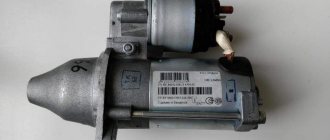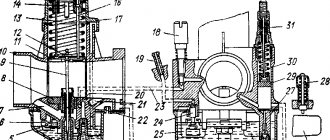Connecting an alarm system to a scooter is sometimes more difficult than installing a security system in a car. The scooter alarm is connected according to one of two standard schemes, and the choice of scheme depends on the type of ignition switch. It would seem that there is nothing complicated here, but the electrical wiring of scooters may have “nuances” that are usually not taken into account during installation. It is impossible to list these nuances, but you can give examples of connection. This is what is done in the text, as well as in the video, which is given at the end.
Features of installing an alarm on a motto
Let's look at the process of installing an alarm system on a motto: the practical part is installing an alarm system - this is the most effective way to resist robbery.
However, if a couple of years ago, in rare cases, expensive parts were effectively sold in motorcycle parts stores, today Chinese versions of alarms have proven to be in demand. Of course, no alarm system can provide a 100% guarantee, but the chances for scooters will increase significantly. Installing an alarm system on a moto is not such a difficult process.
It is important to correctly identify the option, and it will be very easy to find the necessary model by visiting a motorcycle parts store
For a moto, you can choose an alarm system from Chinese manufacturers who are focused on the global market.
Now let’s move on to consider the process of installing an alarm on a motorcycle:
- First, we prepare the place for installation of the alarm system on the motto and provide the wiring.
For these purposes, we remove the plastic from the front, under which there are all the necessary contacts along with the connectors.
The remoteness of the battery in this option is not so important, so you don’t even need to look at it. We fasten the plastic with bolts - just unscrew them and it can be dismantled
In some cases, depending on the motorcycle model, the mount may be different. In this case, it is recommended to read the manual.
In terms of technical characteristics, the installation of an alarm system on both a Japanese-made motorcycle and a Chinese-made motorcycle is almost identical. Therefore, this article does not have any connection to specific models of motor vehicles.
Any of the alarm system kits with instructions that detail the areas in the wiring where it needs to be connected. First, we disconnect the ignition switch chip, since no one can be immune from errors, and when igniting it can ruin your life. Then you need to find the main motorcycle wiring, which is designed as a harness and is located mainly in a polyvinyl chloride pipe. In rare cases, but the main wiring is simply wrapped with insulating tape.
We get to each wiring and select blue, orange and yellow-red. Then we remove the insulation and expose the wiring. You can do it another way and, without damaging the insulating tape, connect the alarm system directly to the chip.
Now you can return to the ignition switch and you need to expose the area of the wire at a distance of approximately 5 centimeters from the chip. You can consider the preliminary work completed.
- We carry out wiring of the alarm system
First you will need to find an area where you can install the central unit. It is recommended to place it under the front plastic if you glue it to the inner area using the special tape that is included in the kit.
For a more durable fastening, we carefully wipe the plastic and then degrease it. When choosing a location, you immediately need to find out the length of the wiring, which is recommended to be cut off rather than hiding the entire mass under plastic. One tourniquet, which is recommended to be left long, is black. And for all others, after determining the length, it is recommended to cut it.
You should definitely leave a couple of centimeters for laying, and expose the ends of any wire by 2 centimeters.
- Connecting the alarm system
The red wire must be connected to the red ignition switch wire by winding one end to the other. We connect the orange wire to the black one in the same way. Then we connect back the ignition switch and alarm system.
https://youtube.com/watch?v=H7cwSYmjfmg
Motorcycle alarms "Starline"
Starline has 2 worthy solutions - the Starline Moto V62 and Moto V67 models.
The V62 system has a 3D shock and tilt sensor and a 128-channel noise-resistant transceiver with a warning range of up to 2000 m. In addition, its non-scannable dialogue code will complicate the life of an attacker who wants to use a special reading device.
With the V67 model, the manufacturer went further. This system has a built-in engine blocking relay, and also has protection against radio interference and an owner authorization function via Bluetooth Smart using an RFID tag or smartphone. This means that the thief will not have time to drive far - remotely you can reduce the vehicle’s speed to a minimum or completely turn off the engine. However, I would omit the second option, since it promises problems with the law, because if you suddenly turn off the engine at 120 km/h, there will be no one to deal with the fact of the theft. By the way, the V67 system includes a reed switch sensor. If there is any attempt to break into the trunk, it will “notify” about it very loudly. It is very convenient to install for yourself or your wife, who, while pleasantly waiting for someone or something and simultaneously looking at herself in the rearview mirror, may not notice the theft.
Installing an alarm system on a scooter with your own hands competently and effectively
Choosing a suitable alarm
Modern security systems, even for small-sized equipment, allow you to use such practical bonuses as a remote control, starting the engine from a distance and some other advantages.
Security systems for mopeds and scooters are almost as diverse as those for cars. Installing an alarm on a scooter traditionally begins with selecting a suitable model. You can choose a security guard based on different criteria:
- manufacturer;
- price;
- degree of protection;
- set of functions.
Retail chains offer security systems from the most primitive and inexpensive made in China to expensive ones that have decent functionality and are also protected from outside interference.
In order not to make a mistake in your choice, evaluate your financial capabilities and recommendations of manufacturers, and also communicate on specialized forums. The best criterion for selection is reviews from owners who have been using alarms for some time. Advice from sellers and service center specialists will also not be superfluous.
When purchasing, you must check the completeness. The average alarm kit consists of:
- central block;
- sound siren;
- vibration sensor (set of sensors);
- key fobs for remote control;
- set of connecting wires with terminal blocks.
Particular attention should be paid to the installation instructions and wiring diagram, because... in their absence, connecting an alarm to a scooter will be quite problematic
Although the principle of operation and the procedure for installing the system into the design of a moped of different models are not fundamentally different, it is better to use the factory instructions and manufacturer’s recommendations.
How to install an alarm on a scooter - step-by-step instructions
Step No. 1: choosing an installation location.
For scooters with a classic layout, the most suitable place for mounting a central unit with a sensor and speaker is a niche under the front plastic covering. Firstly, there is enough free space here. The installed equipment will not interfere with controls and other components. Secondly, this is where the main wiring harness runs, which you need to connect to. Another installation option is in a niche under the seat. It will be more difficult for a burglar to get to this place, but to connect you will have to increase the number of wires.
Step No. 2: installing an alarm on the moped.
Manufacturers of security devices always offer their own method of mounting the unit and sensors. As a rule, double-sided adhesive elements are used for fastening. An option is available using clamps and brackets. The method of fastening depends on the specific alarm model.
Step #3: connection.
How to install an alarm on a scooter without making a mistake in the wiring order?
To ensure the operation of the security system, two prerequisites are required:
- continuous supply of power to the central unit from the battery;
- correct connection to the ignition system.
Before starting work, to avoid short circuits, the ignition is turned off and the battery is disconnected.
- Take the connection diagram and strictly observe the color of the wires;
- To connect the alarm wiring to the moped's electrical network in the places indicated in the diagram, expose the insulation and connect the ends of the alarm connector wires;
- After checking the correct connection, the connection points are soldered and well insulated.
The most important advice for installing security guards
In solving the problem of how to install an alarm on a moped, owners forget about the biggest drawback of these vehicles. Many models, especially Japanese scooters, allow you to get to the battery without much difficulty. This allows the thief to quickly turn off the power and de-energize the alarm.
Experts strongly recommend taking measures to protect the battery. To do this, a protective metal box is made, and the cables are laid in such a way that they cannot be cut through with a plumbing tool.
How to connect an alarm to a scooter
How to connect an alarm to a scooter. Universal circuit for standard signaling
All scooter alarms that are currently on sale and are cheap or budget, have the same type of connection and there is nothing tricky about it. Alarms can be sorted among themselves only by the set of functions and the type of siren - built-in or remote. (Alarms with feedback, additional motion and volume sensors are not considered here.)
There are very simple alarms with only two functions: arming and disarming. Everything is very simple there. There are only two wires that connect to the battery.
And also there are a couple more functions from inexpensive budget ones: start from the key fob, turn off from the key fob, and when the alarm goes off, turn on additional lighting (turn signals). With these functions, questions usually arise about what to connect where. All these alarms have the same set of wires and the same colors, so using the diagram in the picture you can easily figure out what to connect and where.
Red is a plus, we screw it onto the red wire going to the ignition switch from the battery; Black is a minus, we screw it to the frame, to ground; Blue is for the starter (provided that the engine will be started from the alarm button); Orange is so that the alarm goes off when the ignition is turned on, and it also carries a plus to turn on the ignition when starting from the key fob, screw it to the black wire of the ignition switch; You also need to cut the black wire with a white stripe coming from the ignition switch. Pink - screw it to the wire (black with a white stripe) to the part that extends from the ignition switch; Gray - screw it to another part of this wire; Yellow (double) - two double wires, screw one to light blue, the other to orange (this is the exit for turns).
If (suddenly) your wire colors are different, then you will have to be smart and connect by analogy or by elimination.
Moto gadgets
Why was I angry before? I didn't have a bike. And now that my motorcycle has been stolen, I’ll just kill you! © Postman Pechkin, folk version I slowly choose a signal for my endurka. Below the cut is the information that I managed to extract from the internet.
A small educational program so as not to get confused in terms
An alarm with a one-way communication channel is the simplest option; there is no information display on the key fob.
The car is stolen - the siren is screaming, the key fob is silent, no one cares. Alarms with a two-way communication channel (with feedback) - usually there are 2 key fobs: one with an LCD display, the second without it, a spare one. The car is stolen, the siren screams, the key fob beeps and lights up, the owner runs out and gives the thief fair retribution.
The very first alarms with a radio channel had a static code - each command had its own command packet. Since there were few code options, sometimes you could use your key fob to open someone else’s car with the same alarm system - the package formats were the same. Some cheap Chinese alarm systems still use static code.
A dynamic code differs from a static code in that each time the button is pressed, the packet format changes according to a certain law, which is known only to the alarm system and the key fob programmed for it. The most famous dynamic encoding algorithm is Keeloq from Microchip. Analytically, the Keeloq algorithm has not yet been cracked. All the mathematical power of this technology is negated by the physical implementation - no one is trying to select the code. Instead, the package is spoiled, remembered and sent next time. Many security system manufacturers have developed their own dynamic codes, introducing various improvements. Some of them have still not been opened, and seem to be able to be used in security systems. The more individual, small-scale, or newer the product, the lower the likelihood of opening the descriptor from this model range. However, no dynamic code guarantees protection against hacking!
To protect against code grabbers, we developed a double dynamic code (D2) , in which when you press the key fob, not only the code changes, but also the law of formation of a new code. This individual rule is written to the decoder once when programming the key fob; it no longer appears on the air and is not available for radio interception. Even the system developer, having all the necessary information about encoding methods and the appropriate equipment, will not be able to decipher this code. True, the dark side of the Force did not sleep and advanced code grabbers appeared, capable of hacking D2.
The most crypto-resistant and reliable is considered to be the dialogue exchange protocol between the key fob and the main unit, using asymmetric encryption algorithms and a frequency of 2.4 GHz. It requires a two-way communication channel, that is, the presence of a receiver and transmitter, both in the main module and in the key fob. Having received a signal, the system makes sure that it was sent from “its” key fob, and this happens not just once, but in a dialogue. In response to the first signal, the system sends a request to the key fob in the form of a pseudo-random number, which is processed by the key fob using a special algorithm and sent back. The alarm processes its message using the same algorithm, comparing the received response with its data. If they match, the command is executed and a confirmation is sent to the key fob. True, even dialogue coding will not save you from physical theft of a key fob.
A fairly common subtype of feedback alarms is GSM alarms . They can be controlled both from key fobs and from a phone by sending special. SMS commands, or by calling and typing a command in tone mode. Uses a SIM card from any operator. If the GSM signal is lost in security mode, then upon subsequent restoration an SMS is sent. In an emergency, the alarm sends an SMS indicating the reason for the alarm, and also starts calling the owner. A good thing, if not for a couple of nuances: there is no 100% coverage of the territory with cellular communications, there is a high probability of being left in a remote area with a locked bike and a dead smartphone, and the need to pay for communication. In theory, you can add a WiFi module and partially bypass these limitations, but I have never seen ready-made motorcycle alarms of this kind. However, everything is going to the point that we will soon come to a tag + smartphone combination, and the use of key fobs will become a thing of the past.
Jammers for all GSM bands can now be bought at every turn. However, for any tricky nut there is always a bolt with a left-hand thread. In this case, these are GSM channel control modules : every 2-3 minutes, the alarm sends a short mark like “I’m there, everything is ok, coordinates xx, y” to a special server every 2-3 minutes via the GPRS channel. As soon as the server does not receive a signal within the allotted time, an SMS is sent indicating that the connection has been lost.
Some modern alarm systems are equipped with an RFID tag for contactless access (“hands free”), the communication range is up to 10 meters. There is no need to take the key fob out of your pocket and press the button - if the tag is within the range of the alarm receiver, the motorcycle is disarmed. Basically, tags operate at a frequency of 2.4 GHz. On the one hand, it’s a convenient thing, but there are some nuances. According to Alexey Night-hunter, “it’s annoying to constantly set and remove the motorcycle from the signaling device when you are standing not far from the motorcycle and the key is in your pocket, and not in the ignition switch, since the tag is triggered and sends signals in one direction, then in another."
Satellite alarms - determine the coordinates of the vehicle in real time and transmit information via a GSM channel to the monitoring center. In the event of an alarm, the operator calls the owner and can send an emergency response team to the scene. Currently (February 2013) in Russia there is only one satellite motorcycle alarm system - ARKAN Moto. In addition to GSM, it has an independent backup communication channel operating at frequencies from 146 to 174 MHz. In essence, it is not just a satellite, but a radio search alarm and operates on the basis of ARKAN direction-finding autonomous stations. These stations are located in such a way that the system covers the entire city, as well as suburban areas at a distance of up to 100 kilometers (as far as I know, so far only in large Russian cities). The ARKAN radio channel cannot be jammed by means available to car thieves, and it breaks through even from metal shelters, tunnels and multi-level parking lots. Judging by foreign experience, the chances of returning a motorbike with a radio search signal are about 80%.
A GPS/GSM beacon is an extremely useful thing, both as a separate bookmark and as a bonus to the signal. Beacons can be self-powered from lithium-ion batteries or powered from a battery. Autonomous ones are usually enough for 500-1000 SMS, and non-autonomous ones eat up the battery in a couple of days (since the current consumption of beacons is, at best, about 40 mA in the cellular network registration mode, and about 60 mA in the satellite search mode). In sleep mode, the beacon consumes <10mA, but then it has to spend about 30 seconds registering with the cellular network and searching for satellites. And SMS messages are not transmitted instantly... But three migrant workers throw a motorcycle into the Gazelle in one minute.
When the accelerometer is triggered/voltage is applied to the contact, the beacon immediately after turning on sends an SMS: “AAA! I got kicked!!!" When he finds the satellites, he sends another SMS with the coordinates in pursuit: “Master, they’re kicking me here! Save me urgently!!!" And if he doesn’t find satellites, then he writes “Sorry, bro. I don't see any satellites. Run to where you last saw me!!”
If you use an autonomous beacon as a bookmark, you can set the mode to communicate and wait for commands once a day. It won’t be detected by a field scanner if it’s stolen, but then it will send the coordinates of the car (if you hide it deeper so that it won’t be found during a physical inspection).
An advanced version of the beacon – a GPS/GSM tracker – allows you to track the movements of a motorcycle online through a special program/web interface.
Defense strategy
Many are sure that only expensive, pretentious motorcycles are stolen, but this is not true! They steal everything that is bad. Standard theft scheme: jamming - hijacking - transfer to a sump - dismantling the blocks, if they can be found - sediment - transfer to the buyer or accomplice for legalization.
Airbrushing no longer deters theft, because... There is a cheap opportunity to change the exterior with vinyl films. There is no point in installing a secret toggle switch/immobilizer, because... all this can be easily dismantled in the sump.
Motorcycles are stolen either by professionals on a tip, or by local punks. While it is quite difficult to defend against the former, sometimes even a simple blaring signal is enough to protect against the latter. However, mechanical protection should not be neglected. Ideally, protection should be comprehensive. It seems to me that there should be a cool, discreet case, a thick chain with a good lock to the nearest post, a signaling device with an OS and a beacon, and an autonomous beacon-bookmark in a secret place. A video camera that records when a motion sensor is triggered / a photo recorder / a guarded parking lot / an egg-snatching dog / a fighting jungle cat are also welcome =)
From an interview with Andrey Kondrashov, who specializes in car theft protection, I learned that in order to protect a vehicle from theft, it is necessary to make theft highly skilled, unprofitable and time-consuming.
The nameless comrade seter has already given an excerpt from this interview regarding motorcycles:
How can you protect your motorcycle from theft? 1. Mostly, motorcycles are stolen by the full loading method, so when you start moving it, you need to turn on powerful piezo sirens, the sound of which is beyond the pain threshold. The motorcycle will become difficult to move. You either need to cover your ears or move the motorcycle. 2. Notify the owner, who can use a command (from the remote control or phone), after making sure that the motorcycle is being stolen, and activate a smoke cartridge that generates 100 cubic meters of smoke. The assholes will run away in panic, and if they managed to drag him into the Gazelle, they will gladly throw him out. 3. If the motorcycle is still taken away, try to look for it using an autonomous beacon, which can be hidden very well, despite the size of the motorcycle.
TK
Basic requirements: low current consumption, compactness, moisture protection, ability to connect additional.
sensors, sensitivity adjustment, reliability. Low current consumption is a key parameter in motorcycle alarms. From the comments we found out an important nuance: according to Andrey Andsah, “manufacturers indicate consumption under the condition of a normal GSM and GPS signal. If the signal is weak or absent, then the consumption is much greater. By the way, this problem also applies to most alarms with a pager.”
KMK, the most universal version of a motorcycle alarm, is an alarm with interactive radio feedback with a GSM beacon. If any yzargs encroach on the motel, she gives a signal both through radio communication and through a beacon. Where the keychain cannot reach, a text message will fly. In addition, the beacon immediately sends the exact coordinates of the moto. And put a kickstarter on the motor, because such a thing will drain the battery pretty well =)
Options considered
HAWK MOTORCYCLE ALARM X60 + GSM/GPS beacon .
+ price + waterproof + “there is a talking mode in which when the shock sensor is triggered, the siren does not scream, but the motorcycle asks in a human voice to move away. And only when the tilt sensor is triggered or the impact on the shock sensor is as strong as possible, the piezo siren is turned on with full removal of the brains. Accordingly, you can only report alarms via tilt sensor via SMS” ©Andrey Andsah + the kit already includes a siren, immobilizer, volume sensor + you can attach a GSM beacon/tracker - Keeloq dynamic coding algorithm. Protection against hacking by a code grabber is not guaranteed (unlike dialog algorithms). On the other hand, this signaling device is quite rare in Russia... - the current consumption is quite high: the signaling device itself consumes only 1.2 mA, but the beacon consumes about 40 mA in active mode. Price: ~2600 rubles from offsite with delivery to Moscow + lighthouse. HAWK MOTORCYCLE ALARM WITH GPS/GPS TRACKER – a tracker was attached to the HAWK X60. The difference in price with a regular Hawk is 6200 rubles. According to Andrey Andsah, this beacon on dealextreme.com costs 1,500 rubles. Price: ~8850 from offsite with delivery to Moscow time.
M+S LEGOS 2 ALARM SYSTEM + GSM beacon The LEGOS series is the descendants of the discontinued Meta DEF.COM 3 (KTM Alarm System) from MetaSystems. + waterproof + relatively compact control unit (100x66x20mm) + easy installation + the kit already includes a siren; + you can attach a GSM beacon/tracker and a bunch of all sorts of goodies from M+S (like a siren with the ability to play your own audio files. Fill it with Bieber and the thief will die from a sound attack :-D) - dynamic encoding algorithm, no protection against hacking by a code grabber guaranteed - the current consumption is quite high: the signaling itself consumes only 1.8 mA, but the beacon consumes about 40 mA in active mode. - installation is too simple, and therefore removal - price Price: 5400 rubles from louis.de + beacon
M+S LEGOS 4 ALARM SYSTEM – thicker (130x65x37mm) and more expensive M+S LEGOS 2 ALARM SYSTEM with an immobilizer. Price: 6700 rubles from louis.de + lighthouse
SPY 5000m (analogue - BERET Moto 2, CD-MT166 and 100,500 other Chinese clones). On one forum I found some interesting information about this company:
In 2007, the MBA group of companies introduced its brand “SKY” to the Russian auto electronics market. ... After the appearance of the first SKY brand, as is customary in China, duplicates immediately appeared - Spy...
+ price (about $130 with delivery);
+ current consumption <10mA according to the manufacturer; + moisture protection; + remote antenna; + there is an adjustment of the sensitivity of the remote volume sensor; the sensitivity of the shock sensor (in the block) is adjusted from the remote control - 3 positions. + The kit already includes a siren, a volume sensor and 2 key fobs with an LCD display; - the stated range of 5000m is complete nonsense, in reality the communication range is much shorter (maximum 1000m) - dynamic coding algorithm, protection against hacking by a code grabber is not guaranteed Price: $130 with delivery from ebay = ~4500r. As the nameless comrade wasserfall suggested to me in the comments, you can get it from aliexpress.com for $70 (~2200 rubles) with free shipping =) StarLine Moto V62 + interactive encoding algorithm; + current consumption is only 8 mA in security mode (as there is no volume sensor in the drain); + you can check the battery charge from home; + compact control unit (75x63x15mm) + you can connect a bunch of goodies, including a GSM tracker. + easy installation; - despite the seemingly small current consumption, in fact the battery with the alarm on lasts a week - poor water resistance (corrected with a rubber glove with silica gel). The unit is sealed everywhere except the connector. Therefore, it must be placed with the connector down and in a place where dirt will not be blown into it and condensation will not drain - installation is too simple, and therefore removal - “The most hectic adjustment system, with these long and short presses (if the key fob could be suffocated, it would It would have killed me 10 times already)” ©Vitaly Vatson - judging by the reviews, it’s almost the most buggy alarm. True, its buggyness greatly depends on the straightness of the installer’s hands;) Price: 5950 rubles from the dealer + siren
Gorilla 8017 Motorcycle Alarm + waterproof + remote antenna + backup battery in the case + includes a siren, shock sensor, tilt sensor and network voltage sensor + shock sensor sensitivity adjustment: 7 positions - current consumption?? - the encryption algorithm is dynamic, not interactive - the control unit is quite thick (90mm x 65mm x 45mm) - external limit switches cannot be connected - candy bar and built-in siren Price: $205 with delivery from ebay = ~6200r
Scorpio SR-i900 RFID + waterproof + algorithm, although dynamic, but not widespread Keelog + relatively compact control unit (100mm x 70mm x 22.5mm). Starline and Pandora are thinner, but they have an external siren) + backup battery in the case + RFID tag + ease of use and installation, you can buy a pigtail of wires for your moto. + no Starline glitches, RFID works great, there is a package with excellent volumetric sensors that are triggered by proximity - candy bar - current consumption? - the encryption algorithm is dynamic, not interactive - a fairly quiet built-in siren, which can die, and connecting an external one is extremely problematic Price: ~320$ with delivery from ebay = ~10600 RUR
Scorpio rLiNK SR-i1100 GPS/GPRS/RFID Tracking System is essentially a Scorpio SR-i900 + tracker. Price: ~570$ with delivery from ebay = ~17200rub
Pandora DXL 4200 + interactive encoding algorithm; + compact control unit (93mm x 55.5mm x 16mm) + there is an economical mode in which the alarm will always be with the GSM module turned off, and will turn on only when an alarm is triggered, to notify the owner of the danger... but then it will be impossible to call it, to take any action. + notification about critical battery level; + RFID tag + remote engine start, turning on/off locks and using other functions using a mobile phone - complex installation - current consumption is about 20mA (according to Vadim vadopo, this is “3-4 days in our realities”) - “RFID tags based on pandect they have one bad glitch - they may not be caught at a distance of 20 centimeters." They say that this glitch has been fixed in the new tags. In any case, there is manual arming/unlocking via the clutch handle or telephone. - no special mobile application, unlike Scorpio rLiNK SR-i1100 or car Pandora. You have to communicate by dialing the subscriber and then typing combinations of numbers in tone mode. Price: 6300 RUR from the dealer + siren
Pandora DXL 4400 is essentially a Pandora DXL 4200 with an immobilizer included, a CAN bus driver and a cute key fob a la a watch. The old Pandora received a new label with arming and disarming buttons. Another difference from the previous model is the ability to work with the Pandora NAV-03 wireless GPS\GLONASS receiver, which determines the coordinates of the moto upon request. Price: 9970 rubles at the office. dealer in Moscow
The GSM Moto cube is a cheap analogue of Pandora with Keelog, to which you can connect a hell of a lot of different sensors. + price + very compact unit (65x45x22mm) + waterproof + the unit has a GSM/GPS tracker and you can track the location of the moto in the Cube-online system + notification of a critical battery charge level; + remote engine start, enable/disable locks and use of other functions using a mobile phone + unlimited number of connected sensors + unique system of protection against jamming of the GSM signal O_O - current consumption 20 mA in standby mode - Keelog instead of a dialogue algorithm - no special. mobile application Price: main unit with GSM tracker RUB 3,099 + siren + remote sensors + key fobs
Magnum Elite MH-822 is a Ukrainian GSM car alarm system that some pilots installed on their motorcycles. The top models (840, 880) even have a special Android mobile application for controlling this very alarm. + price + current consumption of about 18 mA + remote GSM antenna + Magnum MSS double dynamic code + notification of critical battery charge level; + remote control using a mobile phone + the kit includes a siren, shock sensor and temperature sensor - complex installation, since the alarm was originally designed for cars - waterproof - dimensions of the unit Price: 1100 hryvnia ~ 4200 rubles + tilt sensor + delivery from Kyiv to Moscow
STaRLink eBike – top Israeli alarm tracker + waterproof case included + compactness (92x65x28mm) + lowest current consumption (3-10mA, depending on mode) of GSM alarms + backup battery. True, in active mode (GSM+GPS on) with the ignition on, it still draws 20-30mA. + automatic activation of “sleep mode” (~3.5 mA) with independent exit from it based on one of the events, such as movement/tilt/impact and turning on the ignition. As in Pandora, the GSM module is disabled in sleep mode (there is also GPS). + notification about critical battery level; + remote control using a mobile phone + RFID tag + the unit has a GSM/GPS tracker and you can track the location of the mooch in the Wialon system - the encryption algorithm is dynamic - no special. mobile application Price: 8483 RUR from the dealer + siren
Satellite alarm ARKAN Moto is the only satellite motorcycle alarm in Russia. Unfortunately, I did not find reviews from real owners of this alarm. Either it is not very popular, or people install it and don’t get fired =) + the independent Arkan radio channel cannot be jammed, and then you can use it to find a stolen motorbike (if the alarm is not physically removed) + miniature unit (exact dimensions are not indicated =() + there is a built-in the monoblock system has a rechargeable battery; + the kit includes a GSM tracker and you can track the location of the moto in On-line mode + RFID tag + the kit already includes a siren, an immobilizer, a volume sensor and a tracker with autonomous power supply - current consumption??? - for every sneeze they will call from the monitoring center - an independent radio channel operates only within the range of radio antennas installed by the operator (Moscow, St. Petersburg, Nizhny Novgorod) - costs like a cast iron bridge =((( Price: 30,000 rubles + subscription fee (about 10,000 rubles/ year)
There are 14 alarms in the review, but there’s still nothing to choose from =\ So far I haven’t ordered anything - I’m choosing between Hawk, Pandora and Starlink (they have the most beautiful keychains;)) Perhaps the collective mind of the BP will suggest an even more interesting model of the alarm ?
GPS beacon - alarm for scooter? Not only!
When satellite tracking devices emerged, it was unlikely that they would ever be used for scooters. It was not a cheap pleasure - that’s why the scope of application was limited mainly to the special services. Today, a beacon is purchased as an alarm for a scooter, for car safety, and for many other purposes. In this list:
Child safety. Doesn’t answer calls, stayed late after school, was late for training... While parents figure out what’s what and calm down, gray hair may noticeably increase. The fears of adults are not unfounded: every year about 15,000 children disappear in Russia! Alas, 10% of this number are gradually moving onto the list of missing persons. So the question of whether a child needs a beacon is rhetorical
Explain to your child the importance of such a measure, tell them how to use the panic button - and not a single force majeure will go unnoticed. Monitoring the work of a personal driver. Being late for an important meeting is explained by traffic jams, the use of the car for personal purposes is not verbally confirmed, although witnesses saw it outside the city... Sound familiar? What a regular scooter alarm can never do can be easily solved with the help of a beacon
Just hide it in a secluded place of the vehicle - and your personal “agent” will regularly transmit the most reliable information about the location of the car. Monitoring the movement of valuable cargo. For managers of companies involved in the transportation of goods for various purposes, the problem of their safety and the safety of drivers is especially acute. Truckers often become victims of gangs who not only take possession of the cargo, but also injure the drivers. A GPS beacon, of course, will not scare off criminals, but it is unlikely that they will carry out their plan to the end. Unforeseen stops, deviations from the route - all this will be reflected in messages from the lighthouse. Control over the movement of animals. We went out for a walk and before we knew it, our pet was gone. If this is an isolated case (although it may be the first and the last), then the issue of purchasing a “bug” can be postponed until later. But when this happens regularly, a “amulet” for the animal is simply necessary. Recently, GPS beacons have been purchased by farmers and hippodrome owners, which is understandable. Having expensive breeding cattle or exclusive horses, it is very important to be confident in their safety.
Protection from jammers
Most alarms protect the motorcycle from riffraff, children, drug addicts and just any person who is accidentally tempted by something that is “bad.” But it is very difficult to protect yourself from professional hijackers. Every year they develop more and more new “jammers” for alarms.
The most popular two-way signaling today are GSM options, which can be controlled using calls or SMS, and the latest developments are even Wi-Fi. Devices that jam the GSM signal are now sold at every turn. When a thief with such equipment ends up a few meters from the bike, the motorcycle alarm stops sending a signal, and the owner will not even suspect that something is happening - the key fob is silent.
But the “good guys” have already come up with a way to combat “jammers” - the newest anti-theft devices have specific control of the GSM channel, which consists in the fact that the alarm sends a notification to the server every 1-2 minutes that “everything is fine, the coordinates are such and such” . And if suddenly the notification does not arrive, the server will instantly notify the owner via the key fob - “something happened, the signal has disappeared.”
Radio satellite signaling. In the event of an alarm, the operator contacts the owner of the vehicle, and an operational team is also sent to the site. In addition to the “classic” GSM signal, it uses special frequencies that are inaccessible to hijackers. The system covers the entire city, as well as the area around it at a distance of several tens of kilometers. Unfortunately, such protection is available only in large populated areas of the country.
Installing an alarm system on a scooter with your own hands
An alarm is one of the most effective ways to scare away a thief who is trying to steal your scooter, moped or parts thereof.
But even despite this precaution, scooters and mopeds are subject to theft quite often. Previously, very little had been heard of alarm systems on scooters, and even fewer had used them.
Most likely this was due to the high cost of the kit, if we compare the total cost of motor vehicles. In other words, previously it was completely pointless to install an alarm system on your device, because it could cost the owner almost half the cost of his vehicle.
It is for this reason that many Japanese used scooters and mopeds do not have alarms, like European ones in particular. Today on the market you can buy a budget, but fairly well-made alarm system for motor vehicles - motorcycles, scooters, mopeds. These inexpensive alarm devices can be afforded by almost any segment of the population.
How is a beacon different from an alarm on a scooter?
Anti-theft is an unusual thing, but it enjoys a certain reputation among scooterists. At the same time, it acts more like a “talisman” than as a remedy against theft. Indeed, an alarm installed on a scooter will not be able to detain a thief or neutralize hacking devices. And the worst thing is that you may never see your scooter again.
In this regard, the lighthouse is much more versatile. Its advantages over the alarm system include:
- Compact and lightweight, because the device’s appearance is not much different from a standard bank card
- Reliability and reliability. It is thanks to this combination that a once fully charged device does not need to be recharged for 9 months
- Availability and reasonable price. You spend one time to purchase the device, there are no subscription fees
- Installing a beacon, unlike an alarm on a scooter, does not require any special skills - you just need to know how to use a phone
- Possibility of personal customization provided by the manufacturer
Review of several popular motorcycle signals
One of the main criteria when choosing a signaling device is its price. As it increases, we will study the assortment that can be found on aliexpress:
- A box with “filling” and a battery inside, completely autonomous, from Noname Model FYD-6699. It only triggers when there is a noticeable impact, does not connect to the battery, the lock, or the turn signals, and after a month it begins to severely glitch, triggering at will even in a quiet garage, or not triggering at all. It’s hard to call this an alarm, but thanks to the free price, the Chinese device does not lose its popularity.
- An inexpensive but high-quality one-way motorcycle alarm is the Steel-Mate 2021. It works reliably on motorcycles for years, connects to the battery, lock, turn signals, and responds adequately to impacts, tilts, rolling and jolts, and to an attempt to turn the key in the ignition. It has a powerful siren that will attract the attention of others.
- StarLine Moto V62 is a good budget item from the two-way segment. Consumes quite a small mA, plus it is equipped with a function to check the remaining battery charge without leaving home;
- Pandora DXL 4200 - has an average price, the main difference is a keychain in the form of a bracelet with a display a la watch.
When protecting your motorcycle from theft, remember that if they want to steal it, nothing will save it. But you can minimize the risk that they will even steal it by using a case, anti-theft locks and cables, reliable alarms and beacons.
Nuances concerning both schemes
If you connect the security system as discussed above, you can get a workable option, perhaps without remote start. In general, an alarm system on a scooter can be installed in different ways. For example, if you don't need engine lock, just don't cut the wire and connect the "gray" and "pink" cords. You don’t have to connect the siren or the scooter’s turn signals (at the owner’s choice). Further, all the schemes that have been considered will only become more complicated.
We will equip the motor with remote start
The “blue” wire coming from the signaling connector can supply voltage to the relay that turns on the starter. Let's figure out what to connect it to.
Starter buttonThere may be several wires coming from the “2” button module, if it is present at all. One of them is connected to a standard relay, and when pressed, the following may appear:
- + 12 Volt. Then, connect the cord itself to the “blue” signal wire (T-shaped connection);
- "Mass" potential. If you need autostart, you will have to buy a relay, the normally open contacts of which are connected between ground and the found cord.
When installing an additional relay, turn on the winding between the “blue” wire and ground. In this case, the signaling electronics must be protected with a diode.
Additional relay wiring diagram
“Chapter 1” looked at how to install an alarm on a scooter with a 4-pin and 2-pin ignition. In the second case, for example, remote start is easier to implement:
Autostart, two-pin ignition
The numbers here indicate the relay connection points:
- Contact 30;
- Contact 87;
- Pin 85 (diode cathode);
- Pin 86 (diode anode).
As you can see, no new connection points will be added. The only thing is that you have to stretch the cord from ground to pin 86.
The last paragraph does not apply to any equipment produced in China. Simply, Nexus, Racer, Tachilla and many other scooters use a 4-pin ignition.
Standard connection and circuit selection
Let’s say this is the first time an alarm system will be installed on a moped or scooter. Find out right away how many wires go to the ignition switch - 2 or 4. If there are more than 3 contacts in the terminal block, then the second option is probably used. This is 100% true for Chinese scooters, including Racer Dragon, etc. There usually only 4-pin ignition is used.
Lock with 4 contacts
Signatures here indicate the signaling wiring.
The figure lists the wires and contacts:
- Blue (blue). The wire is used for remote starting. “12 Volts” appears on it when you need to close the starter relay. You don’t have to connect it (isolate it).
- Red and Black (red and black). Signal power supply. It is highly recommended to install a 5-7 A pre-flask.
- Orange (orange). Here the signaling system “observes” the voltage value: there is “+12 Volts” - the ignition is on. Ring out the appropriate cord in the terminal block.
- Pink and Gray (pink and gray). The cables are included in the break of the cord going to the switch (its insulation can be white-black, etc.). This cord receives ground potential when the engine is stopped.
A common mistake is the following. The “gray” wire is connected to the lock terminal, while the “pink” wire goes to the switch. If you do this, nothing will burn, but the system will work with errors.
Now, let's look at the second version of the scheme:
Lock with 2 contacts
As you can see, the same alarm system for a scooter can be used, but it must be connected differently. The point is to correctly determine the type of ignition. The starter wire, by the way, in the second option can be broken “to the button”.
There may be a power cord in the terminal block that does not have a certain potential when the ignition is turned off. This cord, usually “light green”, is not at all the same cable that is cut according to “Scheme 1”.










